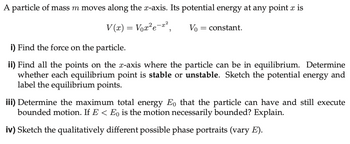A particle of mass m moves along the x-axis. Its potential energy at any point x is V(x) = V₁x²e¯x², Vo = constant. i) Find the force on the particle. ii) Find all the points on the x-axis where the particle can be in equilibrium. Determine whether each equilibrium point is stable or unstable. Sketch the potential energy and label the equilibrium points. ¡¡¡) Determine the maximum total energy E。 that the particle can have and still execute bounded motion. If E < E is the motion necessarily bounded? Explain.
A particle of mass m moves along the x-axis. Its potential energy at any point x is V(x) = V₁x²e¯x², Vo = constant. i) Find the force on the particle. ii) Find all the points on the x-axis where the particle can be in equilibrium. Determine whether each equilibrium point is stable or unstable. Sketch the potential energy and label the equilibrium points. ¡¡¡) Determine the maximum total energy E。 that the particle can have and still execute bounded motion. If E < E is the motion necessarily bounded? Explain.
Related questions
Question
Please be as detailed as possible.

Transcribed Image Text:A particle of mass m moves along the x-axis. Its potential energy at any point x is
V(x) = Vox²e-²
Vo
= constant.
i) Find the force on the particle.
ii) Find all the points on the x-axis where the particle can be in equilibrium. Determine
whether each equilibrium point is stable or unstable. Sketch the potential energy and
label the equilibrium points.
iii) Determine the maximum total energy Eo that the particle can have and still execute
bounded motion. If E < Eo is the motion necessarily bounded? Explain.
iv) Sketch the qualitatively different possible phase portraits (vary E).
Expert Solution
This question has been solved!
Explore an expertly crafted, step-by-step solution for a thorough understanding of key concepts.
Step by step
Solved in 2 steps with 1 images

Follow-up Questions
Read through expert solutions to related follow-up questions below.
Follow-up Question
Please answer the remaining subpart (part (iv)).

Transcribed Image Text:A particle of mass m moves along the x-axis. Its potential energy at any point x is
V(x) = Vox²e-²
Vo
= constant.
i) Find the force on the particle.
ii) Find all the points on the x-axis where the particle can be in equilibrium. Determine
whether each equilibrium point is stable or unstable. Sketch the potential energy and
label the equilibrium points.
iii) Determine the maximum total energy Eo that the particle can have and still execute
bounded motion. If E < Eo is the motion necessarily bounded? Explain.
iv) Sketch the qualitatively different possible phase portraits (vary E).
Solution